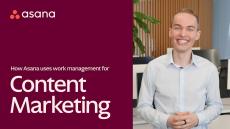|
By Team Asana
As clinical trials grow in complexity, traditional clinical trial management software (CTMS) can fall short. Discover how integrating work management solutions can provide the missing piece to scale operations and keep clinical research operations on track. Consider a global pharmaceutical company launching a complex adaptive trial in oncology. Their clinical trial management software flawlessly tracks patient data, but as the trial expands to more sites, the team drowns in emails and misses deadlines.
|
By Team Asana
Data-driven decision making is the process of collecting data based on your company’s key performance indicators (KPIs) and transforming that data into actionable insights. This process is a crucial element of modern business strategy. In this article, we’ll discuss the benefits of data-driven decision making and provide tips so you can make informed decisions at work. If there’s a looming decision ahead of you at work, it’s often hard to know which direction to go.
|
By Julia Martins
Critical thinking is, well, critical. By building these skills, you improve your ability to analyze information and come to the best decision possible. In this article, we cover the basics of critical thinking, as well as the seven steps you can use to implement the full critical thinking process. Critical thinking comes from asking the right questions to come to the best conclusion possible.
|
By Caeleigh MacNeil
A company’s onboarding process can make or break a new hire’s performance. No one knows this better than Mike Jordan, Asana’s Head of Growth and Impact. With 20+ years of experience under his belt, Jordan helps Asana create the right frameworks to help every employee thrive. His team covers four main areas: Together, these areas make up the entire employee experience at Asana—including the company’s best-in-class onboarding program.
|
By Team Asana
Technical debt is the cost of additional work caused by choosing the quickest solution rather than the most effective solution. Though there are times when technical debt is worth it, it’s important that your team understands the positives and negatives of speedy decisions and how to manage rework in an efficient way. Product managers, programmers, and other stakeholders should carefully consider the trade-offs involved.
|
By Team Asana
It’s challenging to stick to a project plan without clearly defined roles and responsibilities. When you define team roles, you can help teammates collaborate and work through projects more efficiently. In this guide, we’ll explain how to establish roles and responsibilities and why doing so will benefit your team’s mission. You know that chaotic feeling of managing a project where roles and responsibilities are unclear?
|
By Julia Martins
What if we told you listening wasn’t as simple as, well, just listening? In fact, different types of listening go beyond learning—you can also listen to improve your relationships, deepen your connections, and build trust. In this article, we’ll walk you through the different types of listening and show you how active listening can help you listen to understand—not just respond.
|
By Alicia Raeburn
Workplace adaptability helps you react effectively to a variety of situations. In this article, we’ll cover six ways to develop your adaptability skills, including how to become a better problem solver, embrace change, keep an open mind, practice mindfulness, and push yourself out of your comfort zone. The workplace is an ever-changing, dynamic place. A campaign that works brilliantly one day totally flops the next. The colleague you’ve always relied on is suddenly out on leave.
|
By Sarah Laoyan
Taking good meeting notes is an important project management skill to have. By providing your stakeholders with good meeting notes, you’re offering clarity into important conversations and key decisions being made, even if they’re unable to make the meeting. In this article, we discuss different note-taking techniques so you can create effective meeting notes. Meetings are an important part of projects—they are where decisions get made and team members connect with each other.
|
By Julia Martins
Not every company or team has a formal project management process. Whether you work at a large organization or a fast-growing startup, formal project management may not be something your team has prioritized yet. But now, you’re finding it increasingly difficult to stay organized and collaborate with teammates. You might be wondering if you need project management—except that’s just a thing for teams with dedicated project managers, right?
|
By Asana
Welcome to the July edition of What’s new in Asana. This month is all about Asana AI. First, let AI streamline the project creation process with smart projects. Next, write more effective goals based on best practices with smart goals. Finally, use portfolio-level smart summaries to get an AI-generated summary to get up to speed on any notable changes.
|
By Asana
Welcome to the June edition of What’s new in Asana. First, specify the impact of subgoals, projects, and tasks that automatically contribute to a goal’s progress with weighted goals. Next, view capacity plans grouped by projects to manage project staffing. Finally, manage your billing cycle more effectively by temporarily pausing the licenses of inactive users in your domain. For a full list of what’s new this month, check out our Release Notes in the Asana Help Center.
|
By Asana
Palo Alto Networks, a name synonymous with cutting-edge cybersecurity, faced a challenge familiar to many: multiple work management systems created inefficiencies that made it difficult to scale. Their solution? Consolidate into Asana and connect their workforce. Thanks to their visionary leadership, Asana is helping define the future of work at Palo Alto Networks, where AI is an integral teammate accelerating the way work gets done.
|
By Asana
Streamline creative production for smoother, more effective assets. Whether you’re launching a new ad campaign or shooting videos to update your webpage, you can go from idea to published on time and on budget with Asana.
|
By Asana
Asana is where every project, team, and goal come together with AI to propel work forward.
|
By Asana
Welcome to the May edition of What’s new in Asana. First, build rules faster with smart workflows. Next, use the “Viewer” privacy level to give project members view-only access to project information. Finally, filter and sort portfolio items to quickly analyze data and derive insights.
|
By Asana
Bring clarity and visibility to your content marketing team.
|
By Asana
How are executives tackling the challenges of technology-induced friction in the workplace? Our esteemed panelists shared pivotal research from, "The State of Collaboration Technology" and "The State of the IT Leader" reports to discuss actionable strategies for overcoming tech overload. Gain insights that will transform how technology is leveraged within your organization, fostering a more efficient and less stressful work environment.
|
By Asana
Welcome to the April edition of What’s new in Asana. First, create status updates faster with smart status. Asana Intelligence will start a draft status for you, pulling real-time work data in portfolios and goals and highlighting any risks, questions, and roadblocks. Next, save time by quickly duplicating entire sections of tasks within the same project. Finally, use today’s date in a custom field formula calculation to track the duration of progress or time spent on a task.
|
By Asana
Work often includes necessary but repetitive steps. Handoffs to co-workers, approval processes, and triaging requests are all examples of essential, repetitive, and time-consuming work. In this video, learn how to use rules in Asana to automate common steps in your workflows.
- July 2024 (4)
- June 2024 (14)
- May 2024 (15)
- April 2024 (20)
- March 2024 (19)
- February 2024 (20)
- January 2024 (35)
- December 2023 (12)
- November 2023 (12)
- October 2023 (11)
- September 2023 (2)
- August 2023 (5)
- July 2023 (7)
- June 2023 (7)
- May 2023 (4)
- April 2023 (13)
- March 2023 (4)
- February 2023 (15)
- January 2023 (2)
- December 2022 (1)
- November 2022 (2)
- October 2022 (3)
- September 2022 (1)
- August 2022 (6)
- July 2022 (5)
- June 2022 (7)
- May 2022 (3)
- April 2022 (4)
- March 2022 (3)
- February 2022 (7)
- January 2022 (6)
- December 2021 (3)
- November 2021 (4)
- October 2021 (5)
- September 2021 (11)
- August 2021 (5)
- July 2021 (10)
- June 2021 (13)
- May 2021 (7)
- April 2021 (13)
- March 2021 (5)
- February 2021 (2)
- January 2021 (8)
- December 2020 (6)
- November 2020 (5)
- October 2020 (8)
- September 2020 (12)
- August 2020 (9)
- July 2020 (11)
- June 2020 (14)
- May 2020 (12)
- April 2020 (12)
- March 2020 (7)
- February 2020 (3)
- January 2020 (2)
Asana is a leading work management platform used by teams to stay focused on the goals, projects, and daily tasks that grow your business.
Asana helps you coordinate all the work your team does together. So everyone knows what needs to get done, who’s responsible for doing it, and when it’s due:
- Get organized: Plan and structure work in a way that’s best for you. Set priorities and deadlines. Share details and assign tasks. All in one place.
- Stay on track: Follow projects and tasks through every stage. You know where work stands and can keep everyone aligned on goals.
- Hit deadlines: Create visual project plans to see how every step maps out over time. Pinpoint risks. Eliminate roadblocks. Even when plans change.
Asana is free for teams up to 15 members with unlimited projects and tasks. Web and mobile apps are available at asana.com, iTunes, and Google Play.





















